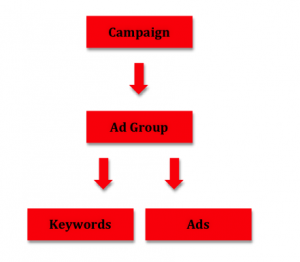It Might Be Time To Revisit Your Account’s Structure

For this month’s series PPC Hero decided to go back to the basics, but with a twist. We’ll be tackling all of the standard best practices for bids, ads, and keywords. But we’ll also share some of our personal insights about what works, what doesn’t, and what you can apply to your own accounts.
Account Structure 101
For today’s lesson, we’re going to start at the very beginning (which is a very good place to start). Before you write ads, generate keywords, segment ad groups, or build campaigns, you need to know how you’re going to structure your account.
This should be a familiar sight to most of you:

Campaigns form the basis of your PPC account. In terms of overall structure, your Campaigns should be segmented by overall themes, and logically structured in a way that gives you the best control over your account. This helps you with tightly-targeted ad copy, better budget control, and great Quality Scores. Overall structure is somewhat individual to the account you’re working in, but let me provide you with an example I’ve used to great success.
Say you have a review site that also sells those products – like Cookies. In this case, you could structure your account along these lines:
- Generic Terms (Baked Goods, Cookies, etc. – all of the most generic ways people can talk about Cookies.) This campaign is a catch-all for Cookie lovers, and you can tightly control the budget depending on your needs.
- Generic Product Terms (Chocolate Chip Cookies, Oatmeal Raisin Cookies, White Chocolate Macadamia Nut Cookies, etc.)
- Product Reviews (Best Chocolate Chip Cookie, Oatmeal Cookie Reviews, White Chocolate Macadamia Nut is the Best Cookie of All Time, etc.)
- Product Ingredients (Chocolate Chips, Butterscotch, Peanut Butter, White Chocolate and Macadamia Nut, etc.)
- Product Goals (Eat More Cookies, Lose Weight While Eating Cookies, etc.)
- Product and Brand-Specific Terms (Mrs. Fields’ Cookies, Pepperidge Farm Cookies, Tollhouse Cookies, Oreo Cookies, Chips Ahoy Cookies, etc.) Depending on how large each brand is, you may also consider splitting them out in to their own campaigns.
- A Site-Branded Campaign for, say, the Cookie Compendium (trademark pending).
Now, this is just a sample structure that works for this specific business model – in this case it segments users based on the sales funnel for this product. Your needs might be different, and that’s totally viable. Your favorite cookie might also be different, and if it’s not White Chocolate Macadamia Nut, we might have a problem.
Now here’s the part where I used to tell you “you should segment by device.” Yeah, about that… There’s no more device segmentation, so you’re going to have to decide what kind of mobile bid modifier you’ll want to use for your campaigns. An adjustment of -20% or so seems to be the recommended amount, but pay attention to your mobile Impression Share. As Enhanced Campaigns become more commonplace, the mobile space will be getting more crowded.
Another note: there’s still value in segmenting your campaigns by Location (especially internationally) as long as your business model calls for it. If you perform better in certain states/countries/cities/regions – segment them out and play to your strengths. If your account is already overloaded with 100+ campaigns, you might consider going with a Location-based bid modifier instead. The choice is yours.
For Display, keep them separate from your Search campaigns. Also, keep them segmented by your targeting type. Your Remarketing Campaign should stay far, far away from your ICM Campaign. Really, my experience suggests that people should stay away from ICM Campaigns in general (although you may have different results).
Anyway, moving on: Ad Groups are where things get a little more complicated.
You’ll want to group your Keywords in to logically consistent, tight Ad Groups that allow you to generate highly relevant copy. Here’s another old favorite image showing what I mean:

This illustration provides you with an idea of how you can segment your keywords with tightly-themed ad groups… but it doesn’t say anything about how to structure your Match Types.
These days, we at PPC Hero have really taken to creating Ad Group variants for each Match Type while utilizing embedded negatives to tightly control your traffic. For the above account, you’d do something like this for the “General Cookies” campaign:
- Cookies General (Exact), containing only Exact Match keywords.
- Cookies General (Phrase), containing only Phrase Match keywords, and Negative Exact Matches of every keyword.
- Cookies General (Broad/Modified Broad), containing only Broad/Modified Broad Match keywords, along with Negative Exact and Negative Phrase Matches of every keyword.
And so on. This can make account management a little more complex, as you’re roughly tripling your ad group count. But you’ll get the benefit of *great* Quality Scores, and the confidence that comes with knowing every query is being funneled exactly how you want it. At least, that’s the idea.
Sean Quadlin will have some more information for you about Match Types later this week, as he’s used the above structure to great effect in some of his accounts (as have we all).
But one other hot tip you can explore with the above structure: keep your Exact, Phrase, and Modified Broad Match keywords in one campaign, but then create another campaign containing only Broad Match keywords. This gives you the benefit of total budget control on your biggest spenders.
So that’s that for today’s short lesson. Check back throughout the week as we get back to the basics with Ad Copy, Keyword Research, Bids, and Match Types.
What do you say, PPC Heroes and Heroines? Any new radical account structure ideas to share with the PPC population? Favorite match type? Favorite cookie type? Let us know in the comments and, as always, thanks for reading!



